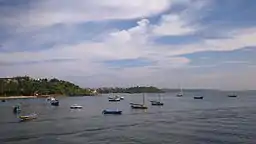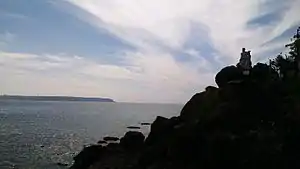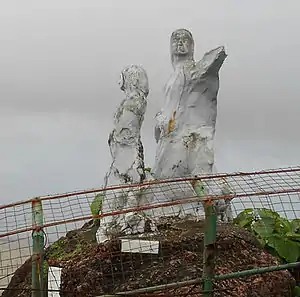Dona Paula
Dona Paula is a former village, and tourist destination, in the suburbs of Panaji, Goa, India.[1] It is today home to the National Institute of Oceanography, and just alongside it lie the Goa University and the International Centre Goa. It is also home to a number of hotels, small and large, and the luxury resort Cidade de Goa is situated in the area.
| Dona Paula Beach | |
|---|---|
 Fishing Boats anchored at Dona Paula, Goa | |
  | |
| Coordinates | 15°27′2″N 73°48′12″E |
| Geology | Beach |


History
The place is named after Da. Paula Amaral Antonia de Souto-Maior, a historical figure in Portuguese India. She was related to the Portuguese Viceroy of Jaffnapatnam in Sri Lanka. She and her family arrived in Goa in 1744 and she married a Fidalgo from Spain in 1756. Her father was D. Antonio Caetano de Menezes Souto-Maior. They were an extremely affluent family, and the entire property from the present day Cabo Raj Nivas all the way to Caranzalem belonged to the Souto-Maior family. She died on 21 December 1782.
Dona Paula was a woman of charity and is known to have helped the villagers and worked a lot for their betterment, so after her death, the villagers decided to rename the village as Dona Paula. Initially the village was called Oddavell.[1]
The Dona Paula Beach is also a major tourist attraction. According to a local myth, Dona Paula is entombed in the Cabo Chapel, the residence of the Governor of Goa and is supposed to be seen emerging from the moonlit waves wearing only a pearl necklace. Several tourists as well as locals guided by this myth visit the beach for a glimpse of Dona Paula. The Cabo Raj Bhavan is situated at a scenic spot in Dona Paula. It is also home of a historic British war-graves cemetery. After the end of Portuguese rule in Goa in 1961, Dona Paula became a fashionable residential area and address.
MYTHICAL OLD LOVE STORY ABOUT DONA PAULA :
Another quite interesting old story has been linked with this Dona Paula beach. Some claim that this is just a rumour, but others say that this story had been linked with an old Portuguese scripture. This story is as follows.
Dona Paula was the young daughter of Portuguese Viceroy Don Antonia Caetano de Menezes, and fell in love with a local Goan fisherman. When the Viceroy found out about their affair, he became very angry and forbade his daughter to meet her lover again.
Extremely sad and upset, Dona Paula couldn't think of life without the fishermen. She felt unbearable pain and immense sorrow without him. When this pain become insufferable, she decided to end her life. In the name of her immortal love, she drowned herself in the Arabian Sea. This way, a true love story came to an end and become a historical reminiscence.
When the Viceroy knew that he had lost his beloved daughter, he was overwhelmed with sorrow and grief. Left with nothing but the memories of his innocent daughter, he decided to name the Arabian Sea area "Dona Paula". This place is a tribute to an eternal romance and love, and gives a message that, if you are ever going to love someone, it should be like Dona Paula's, pure and heartwarming.
Vicinity
Dona Paula is the home to some of the top industrialists and policy makers of the state. It is also the most expensive residential location in Goa. The Raj Bhavan of Goa is located near the La Marvel Colony in Dona Paula.
Tourism
Dona Paula is located on the sea stretch that spans from Panjim, Miramar and Dona Paula is an area frequented by tourists. During the tourist season, Dona Paula transforms into a crowded stretch which is otherwise a calm place during monsoons. A large part of the Hindi movie Ek Duuje Ke Liye was shot here, popularising the place further. An action sequence from Rohit Shetty's movie Singham was shot here. The idyllic rocky tourist attraction lies at the spot where the Mandovi and the Zuari rivers meet and confluences with the Arabian Sea at a distance of 1 km from this point.
One of the attractions in Dona Paula is a whitewashed statue perched on the rocks near the ferry jetty. Sculpted in 1969 by Baroness Yrse Von Leistner, there are different versions to its purpose of origin. According to Goa Tourism Board's website, it is named "Image of India" and depicts the figures of Mother India and Young India, one looking to the East and the other to the West. The Wheel of Ashoka is in the middle half, buried in stone, to represent the ancient culture, that nurtured this blend of ideas and emotions.[2] While in the book 'Walking in Goa' published by Heta Pandit, it is said that the Baroness had actually sculpted statues of philosopher Robert Knox and his wife because she admired him.[3]
References
- Thomas, Blessy (20 April 2007). "The legend of Dona Paula - truth or tall-tale". The Times of India. Retrieved 21 February 2019.
- Dona Paula as described in Goa Tourism Government website
- Thomas, Blessy (20 April 2007). "The legend of Dona Paula - truth or tall-tale". The Times of India. Retrieved 7 July 2016.
External links
| Wikivoyage has a travel guide for Dona Paula. |
| Wikimedia Commons has media related to Dona Paula. |